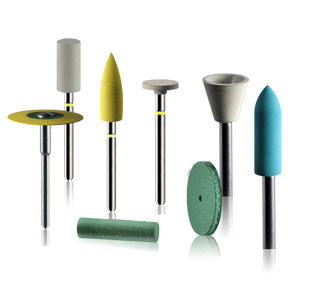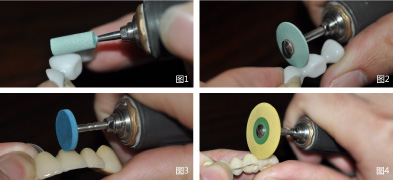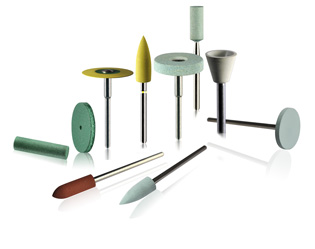
Recommendations for the use of polishing and polishing of technical products-zirconia/ceramic crown polishing and polishing solutions
- Categories:Training Information
- Author:
- Origin:
- Time of issue:2014-06-04
- Views:0
(Summary description)Zirconia/Porcelain Crown Grinding and Polishing Solution
Recommendations for the use of polishing and polishing of technical products-zirconia/ceramic crown polishing and polishing solutions
(Summary description)Zirconia/Porcelain Crown Grinding and Polishing Solution
- Categories:Training Information
- Author:
- Origin:
- Time of issue:2014-06-04
- Views:0

Zirconia/Porcelain Crown Grinding and Polishing Solution:
Workpiece nature:
The hardness of the crystallized zirconia is about 1000pa. In order to take into account the ratio of the shrinkage coefficient before and after sintering of the zirconia before design, the thickness of the full zirconium crown is usually increased by 0.5-1.0mm. The crystallized full zirconium crown product has high hardness and brittleness. The requirement for polishing is relatively high. Excessive heat generation during polishing will cause damage to the molecular structure of the zirconia block and change the original performance. After crystallization, it is necessary to grind the thickness of the connecting part and the crown to the required shape and size. The traditional tool is to polish with emery bur and water to reduce the heat generated during high-speed grinding, which may cause the risk of porcelain cracking. In addition, the grinding of the bur with water will produce mushy dirt, which is not conducive to observing the thickness of the grinding allowance. The slow grinding speed of the bur will consume a long grinding time. In order to avoid such disadvantages, Daobang launched a special grinding for zirconia materials. , Polishing solutions.

Features:
The combined grinder filled with high-density diamond particles and ceramics has a larger contact area with the object to be ground during grinding and can exert high-efficiency grinding power. Good heat dissipation, no need to add water for polishing, and will not cause damage to the workpiece. Can quickly and effectively trim the margin of the workpiece. There is also a polisher that combines diamond particles and rubber. Some products can achieve a smooth and beautiful pre-polishing effect before glazing, and some products can adjust the adjacent and occlusal surfaces after glazing (glazing-free). High-brightness polishing. Achieve an aesthetic restoration effect.

Instructions:
1. After sintering the zirconia crown engraved by the CAD/CAM system, the grinding allowance is firstly polished. Recommended products: a. The recommended product for polishing the outer thickness of the crown (such as CD2023, etc. as shown in Figure 1 and 2, the recommended speed is 20000-30000/s) b .Recommended products for in-position grinding in the crown (recommended speed for CD2143, etc. 15000-20000/s).
2. It is especially important for the polishing of all zirconium crown products before glazing, which directly affects the brightness and smoothness of the glaze. The recommended product for polishing before glazing all zirconium crowns (RD2323 as shown in Figure 3, the recommended speed is 15000-25000/s), if it is a zirconia porcelain crown, this polishing step is not required.
3. For all zirconium crowns and zirconia porcelain crowns that need to be reshaped and polished after being glazed, we have carefully built several special polishers, which do not need to be glazed and sintered again after polishing (mirror effect, no glazing) recommended Products (RD0125, etc., as shown in Figure 4, the recommended speed is 8000-12000/s).

Porcelain crown grinding and polishing solution
Workpiece nature:
Porcelain crowns are made by attaching porcelain to metal or zirconia inner crowns. In order to make the aesthetic restoration effect more realistic. It is divided into the order of OP paste, body porcelain, transparent porcelain and glaze porcelain by using the technology of piled porcelain. In order to consider the shrinkage coefficient ratio before and after the porcelain sintering. Manual piled porcelain will increase the thickness of the piled porcelain by 0.5-1.2mm. After sintering, the limited margin is first polished, and then the glazing and sintering are completed. Note: The fine-tuning, polishing and polishing of porcelain teeth after glazing should avoid the danger of inconsistent color and brittleness caused by glazing and sintering.
Features:
The ceramic grinder can quickly modify the porcelain. A good silicone polisher has excellent heat dissipation, quick smoothing and good pre-polishing effect.

Instructions:
1. For porcelain profiling, first choose a ceramic grinder (CG2062, etc., as shown in Figure 1, the recommended speed is 20000-30000/s) to trim the occlusal surface. Use flat wheels for clamping side and tongue side (CG2342 recommended speed 20000-30000/s), try to avoid using emery bur for shape modification, such as fine and narrow parts must be polished with emery bur, and ultrasonic wave must be used after polishing. The washing machine is used to clean and remove the emery polished residue on the surface of the porcelain crown. The residue will cause cracks after the porcelain crown is sintered.
2. The polished porcelain crown shall be smoothly pre-polished before being dyed and glazed. Recommended products (SH0092, etc., as shown in Figures 2 and 3, recommend a speed of 20000-30000/s)
3. After the porcelain crown is glazed, the parts that need to be reshaped and polished are also several high-brightness polishing products with different particle sizes. After polishing with this type of polisher, there is no need to re-glaze and sinter (mirror effect, no glaze) Recommended products (RD0116, etc., as shown in Figure 4, the recommended speed is 8000-12000/s)

Scan the QR code to read on your phone

Page Copyright ©2021All Rights Reserved.Shanghai TOBOOM Technology Co., Ltd Powered by www.300.cn 沪ICP备2020028574号-1

Scan





